You were sitting in my spot.
Petunia, channeling Sheldon
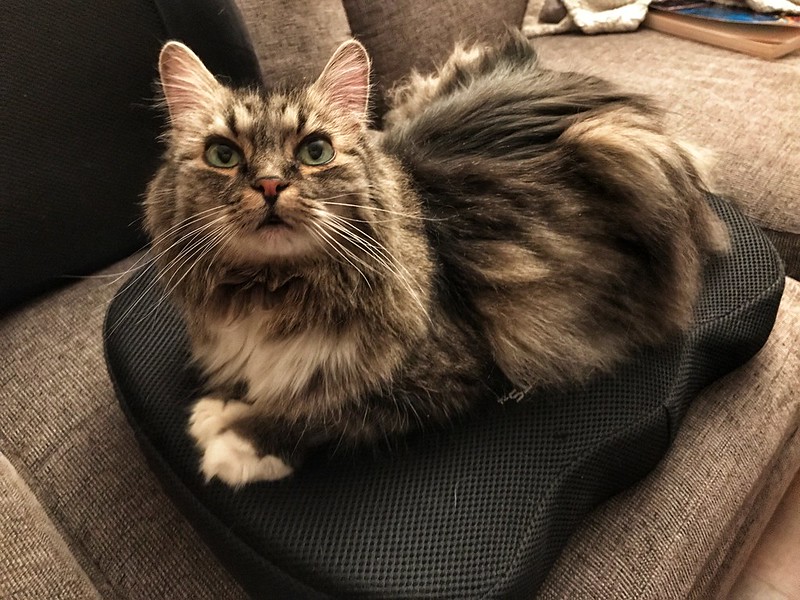

Today is the 100th anniversary of my mother’s birth. I discovered this delightful clipping about a hike to a farm and a picnic with storytelling under a big tree she helped to organize. It could be straight out of Anne of Green Gables.
I love finding these blurbs. This and others are giving me new insight into my parents’ early lives pre-me.
I jest, but this does bring back memories of visits back and forth when I was young enough to be bored but old enough to appreciate any change in routine. This was a visit without us, though.
This morning I, “Dianne Schirg,” made this marvelous discovery from a simpler time when a family visit to Bellwood, Pennsylvania, was noteworthy.
I haven’t moved since I posted “Magnetic personality” in 2008, but my refrigerator was replaced with a newer model in a different location after an apartment remodeling. Not too long ago, I finished redecorating it with magnets I’d found recently. Here we go:
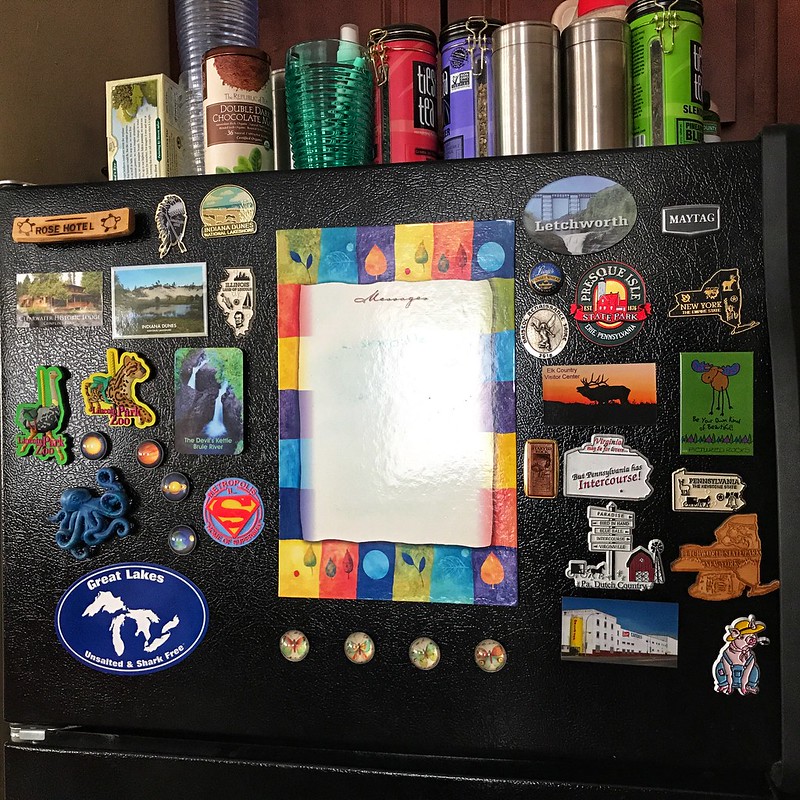
A few years ago I did a search on my dad’s name and found an old auction for V-Mail (“Greetings from Britain”) from Private Ralph Schirf. I hadn’t known about the auction, long since over, in time to bid. Here are the clues that it’s from my dad:
I would love if the buyer found this post and offered to sell me Dad’s V-Mail, but in lieu of the physical pieces I’ll have to be content with small digital photos.
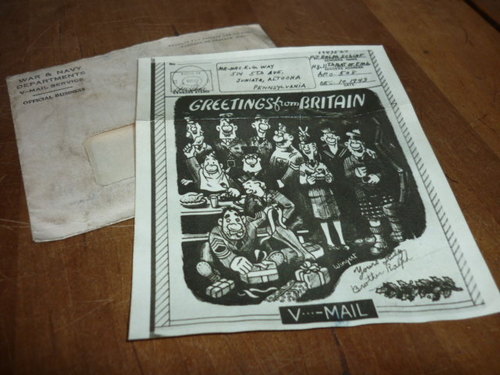
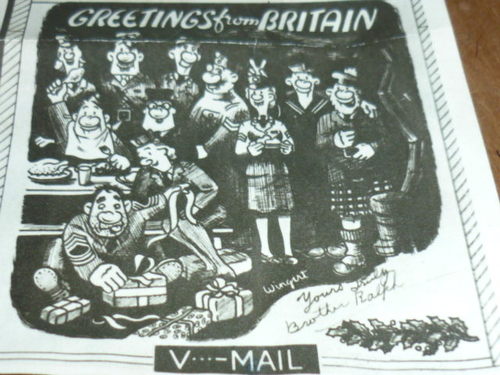
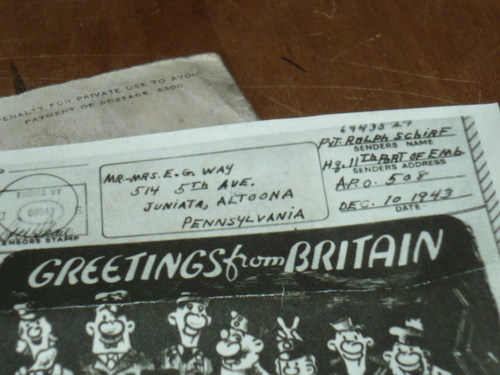

Here’s more from the Postal Museum about V-Mail.
USPS PDF about the history and process of sending V-Mail.
My dad:

And his grave in Bellwood, Pennsylvania, outside Altoona:

Right now, all over the world, a nearly infinite number of things are happening. Hawks pursue rabbits; factions make war; dust filters through the atmosphere; buildings burn; stars shine; children die. Things happen, and everything changes. No one can comprehend it all, only what we experience. Our limitations are our protection; in omniscience lies madness.
My thoughts rambled on during the train trip from Chicago to Ann Arbor. In my limited view from one of the train’s windows, it was a perfect, sunny mid-September day, and in the back of my mind I was looking forward to a weekend spent with friends. I gazed out the window, unable to focus on reading or the other usual train pursuits.
The Amtrak passenger train braked more suddenly than usual, throwing everyone slightly forward. It seemed a strange place to stop, in the middle of a crossing in Albion, Michigan. Sometimes passenger trains halt to allow their freight brethren to pass, but generally the delay takes place out of the way and doesn’t interfere with auto traffic. To me, sitting in the second car, just on the crossing, this stop felt different.
It was.
A couple in an auto waiting at the crossing got out and walked toward the train. I wondered why.
At first, the passengers continued their pursuits — chatting, reading, listening to music through earphones, eating, drinking, or staring out the window, perhaps thinking of what the end of the trip held — reunion with family, school, work. At last, however, the low buzz of activity and conversation heightened as more people noticed how unusually long the train had stopped. A few made joking comments. The uniformed personnel who generally bustle back and forth between the cars had all disappeared. There was no one to ask about the delay.
A rumor from the first car floated back to mine; the train had hit a person in a motorized wheelchair. A motorized wheelchair? What is the likelihood of a motorized wheelchair being in the crossing just when a train is coming? In a small town in Michigan? Then, what is the likelihood that someone would think up that particular scenario?
Someone must have been hit or hurt, or perhaps become seriously ill; a PA announcement requested that any medical professionals on the train make their way to the café car.
The Albion police and two ambulances arrived. The police quickly set up the yellow “Police Line — Do Not Cross” tape around the triangle bordered by the train’s first car and a half and the grassy area next to the crossing, using several convenient trees. Two young women, late ‘teens or early twenties, stood on the grass, hugging each other and crying. The couple from the auto and then the paramedics talked to them and tried uncomfortably to comfort them. I wondered if they had seen the accident, or if they knew the victim well. For a while, they sat on a curb next to the crossing, but at some point they must have left. I wondered if they would seek professional help.
The conductor walked through the train asking that people not open any of the outside doors. “It’s very morbid, believe me,” he said. I knew then that the medical professionals requested earlier were not for the accident victim, but for someone else.
Both ambulances were parked for at least an hour, lights flashing and paramedics walking about, but no one seemed to be doing anything; it all seemed very disorganized and haphazard, almost dreamlike. Finally, both ambulances left, leaving only the police and what were most likely witnesses as well as the invariable spectators. By now, even the couple in the auto had driven off.
For a long time, the police wandered around aimlessly, at least to my inexperienced eyes. One man, sporting long hair and civilian clothes, talked to nearly everyone else, including the police and witnesses, although his role was unclear. He gestured and pointed quite a bit. He remained on the scene during the entire investigation. Other people noticed him as well and wondered who he was.
Meanwhile, the people on the train were becoming impatient. The man across from me spoke of a birthday party in Dearborn he was to attend, schedule for 6 p.m. Two women in front of me were going to two separate wedding showers. When they discovered their purpose in traveling was identical, even though the destinations weren’t, they fell into a deep conversation.
Some of the police began to board my car and walk toward the back, returning to the front and exiting a few minutes later. It occurred to me that they were probably using the lavatory. A crowd had gathered in the foyer between the first and second cars, and the police and conductors had to make their way through them. I didn’t see any reason for the convention, other than to be in the way or to see something of the action. They were a chatty, laughing group.
As the quarter hours, half hours, and hours passed, the passengers became more restless and agitated, wondering how long it would be before the train would be allowed to move on. A very young police officer told our car that the area was considered a “crime scene” and that they could not allow people off the train to contaminate the integrity of the scene. The photographers and others still needed to do their work. They were working as quickly as they could, he said, but could not make any promises about when the train would be released. I wondered what the “crime” was.
I overheard that we were waiting for another engineer to arrive; the train’s engineer was too traumatized to continue. I wasn’t surprised. I’d read before that train engineers involved in accidents suffered trauma long afterwards. Imagine seeing that you are about to hit someone and that that person is about to die. This probably has happened to many an auto driver, but without the surety of death, nor the particularly grisly qualities of a collision between train and human. Most likely only an engineer who has experienced that sickening moment fully understands the trauma and its reasons.
The passengers I heard talking didn’t say much about the victim or the circumstances. Most felt primarily inconvenienced and talked about why with people nearby. Some complained that no one from either Amtrak or the police was providing us with necessary information about when the trip was to resume. There was a rush toward the train’s only phone; one person came back and said offhandedly to anyone listening, “Don’t even think of trying to get to the phone.” “There a line?” one man asked. “Is there ever!”
Outside, the sun continued to create the perfect day. I looked out the window, forward, and for the first time noticed a motorized wheelchair. The police must have put it there within the last half hour. Next to it lay something covered in white. I must have reacted; the man across from me asked me if I’d seen something. “No, not really,” I answered. I didn’t want him or anyone else to talk about what lay under the white. I tried not to look at it, but it was directly in my line of my vision. I saw it and thought, “Only a couple of hours ago, that was a person, maybe going somewhere, just like I am, just like we all are. No more. Just lying there, an object for investigation.”
The police walked around the wheelchair and the body. A photographer appeared and took several photos of the site, including the wheelchair. Another lifted the white material as well — from the other side — and snapped several shots from several angles. The majority of people on the train were unaware of the grisly proceedings.
The man across from me opened a plastic bottle of diet soda. I was thirsty, too, but it seemed disrespectful to satisfy that living desire in the presence of recent death.
On the corner parallel to the train and the crossing, a small herd of boys on bicycles gathered. Each stood poised over his bicycle’s seat, watching the proceedings. It must have been at least 3:30 or 4:30 by then. School was out.
Another police officer boarded the train. He quietly asked the first few people some questions and seemed to disbelieve their answers. He looked around and asked loudly and a little plaintively, “Didn’t anyone see anything?,” as though he couldn’t believe what he had heard. The passengers looked at each other in puzzlement. How could people sitting in the second car be expected to see what must have happened at the front of the train? A young policewoman joined him; they asked each passenger for his or her name, date of birth, address, and phone number, as well as if he or she had seen anything and how fast the train was going at the time of the accident. This last question seemed pointless to me. A train’s speed is very deceptive; usually they are traveling much faster than it feels to the passengers. I suspect the answers ranged from five mph to 70 mph — all subjective guesses and not very reliable in determining exactly what happened. My own estimate was 15-20 — but I would not swear to that.
People continued to be increasingly restless. Another rumor began circulating — that the train was going to back up to the last station, which was quite a way back, so the police could get clearer photographs and drawings. The complaints began again. “I’ve got a better idea — why don’t we move forward?” Not too long after, the train started backing up, and several passengers began groaning. I watched the wheelchair and the white-covered mass recede before me.
The train did not back up to the last station, but just far enough to be out of the way of the police and probably most of the crossings. The passengers became louder as more and more talked to each other. A series of conversations unrelated to the accident arose as people found out where their neighbors were from, where they were traveling to, and why. The little mob in the front of the car continued to banter and laugh. I kept thinking of the shape lying a few blocks ahead.
Eventually, the engineer arrived, and the police cleared the train to leave. From Albion to Ann Arbor was a fast, uneventful journey; I arrived at 6, about four or five hours late. By then, the day’s bright sunlight was muted with the oncoming night. Later, my friends took me to dinner and then to a nostalgic toy store. Even then, I couldn’t help thinking of the white-covered figure and what it might have been doing had it not been for bad timing — or, perhaps, from its perspective, the timing had been perfect. And how it would never see another bright mid-September day. I thought such thoughts until they became too painful, too overwhelming. I could not think them for the millions of others who died that day. I cannot think them now.
1998
Copyright © Diane L. Schirf